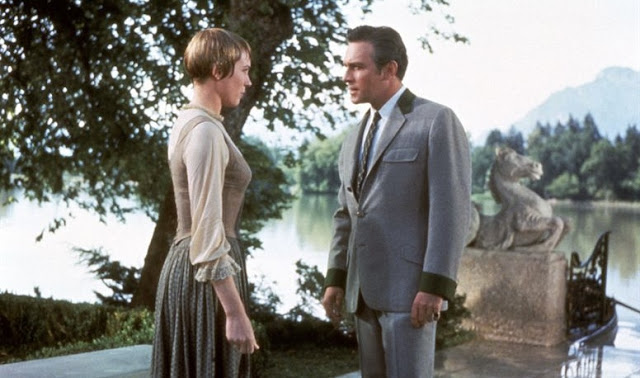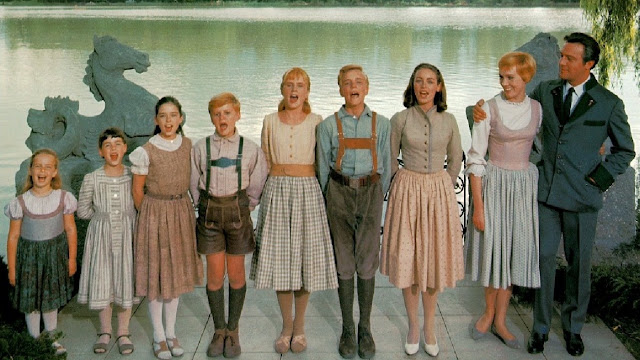The camera hovers over the sweeping landscape of the Swiss Alps, explores the beauty of the buttercups decorating the hillside, then hones in on Julie Andrews as she traverses the countryside and sings the iconic words: “The hills are alive with the sound of music.” Thus opens one of the greatest movies of all time, an epic of music, themes, and wartime drama wrapped up in a love story steeped in personal tragedies. This is Rogers and Hammerstein at their best, both musically and dramatically, with many songs from the soundtrack becoming standards including that opening number.
The Sound of Music began life as a memoir of Maria von Trapp entitled: The Story of the Trapp Family Singers first published in 1949. The memoir was loosely adapted into a West German film entitled The Trapp Family. This was then converted into a stage musical by Howard Lindsay and Russell Crouse with music and lyrics by Rogers and Hammerstein. This would be Rogers’ final composition as the cancer he was fighting at the time took his life less than a year after the Broadway premiere. In 1965 that Broadway show was adapted into a film starring Julie Andrews and Christopher Plummer, a film that would be so popular and so associated with the two leads that both would try to distance themselves from it in their own way. Julie Andrews looked to change her goody goody image thanks to this and her performance in Mary Poppins by starring in a slew of R rated films directed by her then husband Blake Edwards. Plumber simply chose to be dismissive whenever anyone asked him about it, preferring not to focus on triumphs of the past.
The story is based on the von Trapp family but the true story is much different than what is presented on stage and screen. Maria (Julie Andrews) is a free-spirited young Austrian woman intent on becoming a nun at Nonnberg Abbey in Salzburg in 1938. Her carefree attitude, however, has frustrated the sisters and when word is delivered that the baron, retired naval officer Captain Georg von Trapp (Christopher Plummer), recently widowed father of seven children, is in need of a new governess, the sisters recommend Maria for the position. Upon arrival, Maria is shocked to find that the family is being ran like a military vessel with each of the seven kids marched in like soldiers and answering to a whistle. The baron is still suffering from the loss of his wife and anything, the kids included, that reminds him of her is kept at a distance. This has caused the kids to feel unwanted, acting out in a way that has ran off all the previous governesses. The baron frequently travels to Vienna to visit the baroness Elsa Schraeder, a wealthy socialite whom he doesn’t love but wishes to marry anyway. These visits often keep him away from his children for long periods of time.
Maria immediately ingratiates herself with the children by not treating them so harshly, actively learning about each of them, and encouraging them to sing and play games, something their father has all but forbidden them from doing. Her gentle, but firm handling of the children eventually wears down their father’s gruff façade and he is able to see them for who they are again, even singing with them a song of his country that has strong emotional ties with him, Edelweiss. Later, at a social gathering at the house, the children sing a song of good night to the guests and impress them with their performance and charm. At the gathering, the baron shares a traditional Austrian dance with Maria and begins to realize that he is falling in love with her, something that he doesn’t feel for the baroness Elsa. Meanwhile, tensions are building as the Third Reich is annexing Austria and the baron is being ordered to the German naval base at Bremerhaven to accept a commission in the Kriegsmarine. He is strongly against the Nazis and their ideology and prepares the family to flee to Switzerland instead.
This is truly one of those films that quite literally hits all the right notes. From that opening shot of the Swiss Alps to the closing one of the whole family traversing the mountains into Switzerland the scenery is just gorgeous. There is quite simply no scene more iconic than that of Julie Andrews twirling through the buttercups and singing the opening number. Years later when the Oscars were celebrating seventy years of the best films of all time through a montage of clips this moment was used to represent The Sound of Music and it got an overwhelming standing ovation the moment those yellow flowers and Julie Andrews appeared on screen. This image graces many of the film’s posters as well as the covers of the various home video releases. For most, this scene represents the movie as a whole. It definitely sets audiences up for an epic in both the visuals and the songs.
Julie Andrews was no stranger to musical theater. She first caught the eye of Richard Rogers during her stage performances as Eliza Doolittle in My Fair Lady and was featured in, concurrently with My Fair Lady, a role in Rogers and Hammerstein’s Cinderella, a television musical. When My Fair Lady was made into a film, inexplicably Julie Andrews was passed over for the role she made famous in favor of Audrey Hepburn who could not sing. The slight was short lived though as it opened up the door for Andrews to appear in Mary Poppins that same year followed by The Sound of Music just one year later cementing her as a bonafide star of the movie musical. She had it all, too: charisma, screen presence and vocal chops to spare.
Christopher Plummer was primarily a television actor before making the leap into film with The Sound of Music. The film was a huge success and launched a decades long career that lasted all the way until his death in 2021. Still, he viewed the whole affair as dreadful, often mocking the film and his character and refusing to attend any cast reunions or anniversary celebrations until finally relenting in 2010 for The Oprah Winfrey Show. He deemed the character dull and boring and the filming process tedious. Indeed, his character is rather too stiff at times but gets the occasional moment to shine as he warms up to Maria and starts to fall in love with her. His opinion is as valid as anyone’s but isn’t shared by the majority of viewers who have embraced this film as a timeless classic and made it the best selling movie at that time, eclipsing Gone With The Wind.
Knowing history it becomes clear early on that the impending Nazi annex is not far off when the film begins and throughout the first two hours there are little asides that hint at that. This comes in full force during the final hour and it becomes a cat and mouse game as the baron tries to flee Austria before he can be forced to join up with the Nazis. This part of the film has its tense moments but is a little too abrupt on screen. The whole escape sequence is the final twenty minutes of the film which also includes amongst it the von Trapp’s final performance in front of an audience of spectators. By the time the family disappears and the Nazi officers start tracking them down there is just ten minutes before the film is over. This is a long movie but this ending definitely feels rushed.
This is a wonderfully realized adaptation of the stage musical which was a terrific, if inaccurate, adaptation of the memoir of Maria von Trapp. It’s beautiful and cinematic and the music is catchy as all good Rogers and Hammerstein music is. Very rarely does a stage musical translate so perfectly to the big screen but this is one of the rare occasions when it knocks it out of the park. It is one of those rare films that is practically perfect and has stood the test of time, cemented as a classic film for the ages. Incidentally, this film failed to make a mark in Austria where the citizens ignored it because of the many historical inaccuracies. Since then public opinion there has softened a little. Many films from this era have gotten forgotten by the younger generation as the world moves on but The Sound of Music still endures on, transcending generational viewing and remaining in the cultural zeitgeist long after its contemporaries have drifted off into relative obscurity.
Academy Award Nominations:
Best Picture: Robert Wise (won)
Best Director: Robert Wise (won)
Best Actress: Julie Andrews
Best Supporting Actress: Peggy Wood
Best Scoring of Music - Adaptation or Treatment: Irwin Kostal (won)
Best Sound: James Corcoran and Fred Hynes (won)
Best Art Direction - Color: Boris Leven, Walter M. Scott and Ruby Levitt
Best Cinematography: Ted D. McCord
Best Costume Design - Color: Dorothy Jeakins
Best Film Editing: William H. Reynolds (won)
____________________________________________________
Release Date: March 2, 1965
Running Time: 174 Minutes
Rated G
Starring: Julie Andrews, Christopher Plummer, Richard Haydn, Peggy Wood, Charmian Carr and Eleanor Parker
Directed By: Robert Wise









Comments
Post a Comment